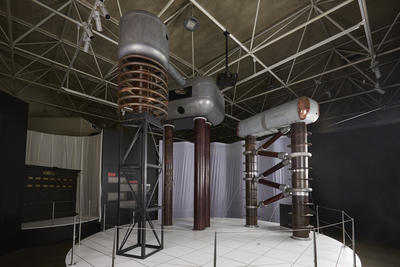Particle Accelerator [Cockcroft-Walton type]
Maker and role
Dr Leo Hobbis, Maker
University of Auckland, Other contributor
Production date
1948-1953
See full details
See video
Object detail
Accession number
1989.21
Secondary maker and role
The General Electric Company Limited: Manufacturer
The General Electric Company Limited: Manufacturer
Unknown: Maker
The General Electric Company Limited: Manufacturer
Unknown: Maker
Description
Cockcroft-Walton Type Nuclear Particle Accelerator used to study atomic structure. Designed and built at the then Auckland University College, now Auckland University, between 1948 and 1953 as part of a doctoral thesis by Dr Leo Hobbis.
Parts for the machine include a high voltage generator, an acceleration tube, voltage multiplier diodes and capacitors, an analysing magnet, diffusion vacuum pump and connecting tubes. Two large Kenotron thermionic rectifiers (KR-5) made by General Electric were used in the original 200 kilovolt (kV) configuration, and were replaced by 6 selenium solid state rectifiers in the later 600 kV configuration. The ion source power supply was powered by lead acetate batteries (car batteries).
Parts for the machine include a high voltage generator, an acceleration tube, voltage multiplier diodes and capacitors, an analysing magnet, diffusion vacuum pump and connecting tubes. Two large Kenotron thermionic rectifiers (KR-5) made by General Electric were used in the original 200 kilovolt (kV) configuration, and were replaced by 6 selenium solid state rectifiers in the later 600 kV configuration. The ion source power supply was powered by lead acetate batteries (car batteries).
Brief History
In the 1930s John Cockcroft and Ernest Walton, two physicists working at Cambridge University’s Cavendish Laboratory with Ernest Rutherford, designed and built what became known as the Cockcroft-Walton Particle Accelerator. Cockcroft, who initiated the research, was trying to prove a proton could be accelerated with enough energy that it could enter and disintegrate the nucleus of an element.
The device, often referred to at the time as an atom smasher, was used to generate a high voltage, up to 600 kilovolts, which could accelerate the positively charged nuclei of atoms. These high velocity particles then bombarded the nuclei of a target. From the type and angular distribution of the resulting emissions the fundamental nature of nuclear force and of nuclear structure could be studied.
There was a lot of interest in better understanding this subject after World War II, when scientists had produced the first nuclear bomb, although without a complete understanding of nuclear physics. This particle accelerator, built by Dr Leo Hobbis at Auckland University as part of his doctoral thesis, "A Low Energy Cockroft-Walton Accelerator", and based on the Cockcroft-Walton particle accelerator, kept New Zealand at the forefront of science.
The device, often referred to at the time as an atom smasher, was used to generate a high voltage, up to 600 kilovolts, which could accelerate the positively charged nuclei of atoms. These high velocity particles then bombarded the nuclei of a target. From the type and angular distribution of the resulting emissions the fundamental nature of nuclear force and of nuclear structure could be studied.
There was a lot of interest in better understanding this subject after World War II, when scientists had produced the first nuclear bomb, although without a complete understanding of nuclear physics. This particle accelerator, built by Dr Leo Hobbis at Auckland University as part of his doctoral thesis, "A Low Energy Cockroft-Walton Accelerator", and based on the Cockcroft-Walton particle accelerator, kept New Zealand at the forefront of science.
Media/Materials
Other name
The Cockcroft-Walton Accelerator
Voltage multiplier
Voltage multiplier
Credit Line
Dr Leo Hobbis et al. 1948-1953. Particle Accelerator [Cockcroft-Walton type], 1989.21. The Museum of Transport and Technology (MOTAT).
Related exhibitions



Public comments
Be the first to comment on this object record.